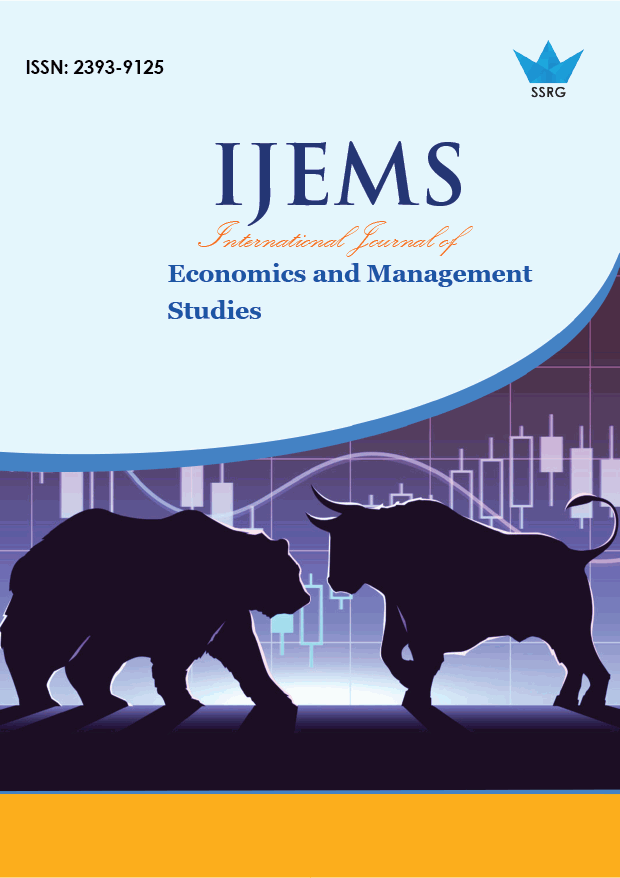Antecedent And Consequences From Ceo Turnover Rate In Indonesia

| International Journal of Economics and Management Studies |
| © 2019 by SSRG - IJEMS Journal |
| Volume 6 Issue 5 |
| Year of Publication : 2019 |
| Authors : Mardianto, Willy Arafah |
How to Cite?
Mardianto, Willy Arafah, "Antecedent And Consequences From Ceo Turnover Rate In Indonesia," SSRG International Journal of Economics and Management Studies, vol. 6, no. 5, pp. 47-51, 2019. Crossref, https://doi.org/10.14445/23939125/IJEMS-V6I5P108
Abstract:
This study aims to explore the antecedent factors of CEO turnover rates in Indonesia and their impact on the performance of companies listed on the Indonesia Stock Exchange. The originality of this study was to use political connection as one of the antecedents to measure the consequences of CEO turnover in influencing company performance. Very little research in Indonesia or in ASEAN countries uses CEO turnover as a mediating variable in measuring the relationship between political connection and company performance. This study uses partial least square analysis to test all research hypotheses. Research data in the form of secondary data taken from financial statements and annual reports of companies listed on the Indonesia Stock Exchange from the period 2012 to 2017. The results showed that political connection and family ownership had a significant effect on CEO turnover rates. In addition, political connection, family ownership and CEO turnover have a significant effect on company performance. The mediating effect of the CEO turnover rate is able to strengthen the significant influence of political connection and family ownership on company performance.
Keywords:
CEO turnover rates, company performance, political connection
References:
[1] Adhikari, A., Derashid, C., & Zhang, H. (2006). Public policy, political connections, and effective tax rates: Longitudinal evidence from Malaysia. Journal of Accounting and Public Policy, 25(5), 574–595. https://doi.org/10.1016/j.jaccpubpol.2006.07.001.
[2] Aguilera, R. V., & Crespi-Cladera, R. (2012). Firm family firms: Current debates of corporate governance in family firms. Journal of Family Business Strategy, 3(2), 66–69. https://doi.org/10.1016/j.jfbs.2012.03.006.
[3] Aloulou, W. J. (2018). Examining entrepreneurial orientation’s dimensions – performance relationship in Saudi family businesses: Contingency role of family involvement in management. Journal of Family Business Management, 8(2), 126–145. https://doi.org/10.1108/JFBM-02-2018-0007.
[4] Bammens, Y., Voordeckers, W., & Van Gils, A. (2011). Boards of directors in family businesses: A literature review and research agenda. International Journal of Management Reviews, 13(2), 134–152. https://doi.org/10.1111/j.1468-2370.2010.00289.x.
[5] Chua, J. H., Chrisman, J. J., Steier, L. P., & Rau, S. B. (2012). Sources of Heterogeneity in Family Firms: An Introduction. Entrepreneurship: Theory and Practice, 36(6), 1103–1113. https://doi.org/10.1111/j.1540-6520.2012.00540.x.
[6] Craig, J. B., Dibrell, C., & Garrett, R. (2013). Examining relationships among family influence, family culture, flexible planning systems, innovativeness and firm performance. Journal of Family Business Strategy, 5(3), 229–238. https://doi.org/10.1016/j.jfbs.2013.09.002.
[7] Du, J., & Girma, S. (2010). Red capitalists: Political connections and firm performance in China. Kyklos, 63(4), 530–545. https://doi.org/10.1111/j.1467-6435.2010.00486.x
[8] Fisman, R. (2001). American Economic Association. The American Economic Review, 91(4), 1095–1102. https://doi.org/10.1126/science.151.3712.867-a.
[9] Jenter, D., & Kanaan, F. (2015). CEO turnover and relative performance evaluation. Journal of Finance, 70(5), 2155–2184. https://doi.org/10.1111/jofi.12282.
[10] Krause, R., & Semadeni, M. (2014). Last dance or second chance? Firm performance, CEO career horizon, and the separation of board leadership roles. Strategic Management Journal, 35, 808–825. https://doi.org/10.1002/smj.
[11] Lindrianasari, & Hartono, J. (2011). The relationship between accounting performance and CEO turnover:
evidence from Indonesia. Accounting & Taxation Review, 3(2), 97–108.
[12] Morck, R., Yeung, B., & Yu, W. (2000). The information content of stock markets: why do emerging markets have synchronous stock price movements? Journal of Financial Economics, 58(1–2), 215–260. https://doi.org/10.1016/S0304-405X(00)00071-4.
[13] Murphy, K. J., & Zimmerman, J. L. (1993). Financial performance surrounding CEO turnover. Journal of Accounting and Economics, 16(1–3), 273–315. https://doi.org/10.1016/0165-4101(93)90014-7.
[14] Pfeffer, J., & Salancik, G. R. (1978). The external control of organizations : a resource dependence perspective. New York: Harper & Row. Retrieved from https://lib.ugent.be/catalog/rug01:001376664.
[15] Piotroski, J., Wong, T., & Zhang, T. (2010). Political incentives to suppress negative information: evidence from Chinese listed firms. Working Paper, 1–56. Retrieved from http://research.chicagobooth.edu/~/media/C2EBFFAF9FB945A8AFDDFC53A1786AD2.pdf.
[16] Rachpradit, P., Tang, J. C. S., & Ba Khang, D. (2012). CEO turnover and firm performance, evidence from Thailand. Corporate Governance: The International Journal of Business in Society, 12(2), 164–178. https://doi.org/10.1108/14720701211214061.
[17] Setiawan, D., Phua, L. K., & Chee, H. K. (2017). CEO turnover and market reaction in Indonesia. Indonesia Capital Market Review, 5(2), 85–94.
[18] Shyu, J. (2011). Family ownership and firm performance: Evidence from Taiwanese firms. International Journal of Managerial Finance, 7(4), 397–411. https://doi.org/http://dx.doi.org/10.1108/JEIM-07-2014-0077.
[19] Taras, V., Memili, E., Wang, Z., & Harms, H. (2018). Family involvement in publicly traded firms and firm performance: a meta-analysis. Management Research Review, 41(2), 225–251. https://doi.org/10.1108/MRR-05-2017-0150.
[20] You, J., & Du, G. (2012). Are political connections a blessing or a curse? Evidence from CEO turnover in China. Corporate Governance: An International Review, 20(2), 179–194.

 10.14445/23939125/IJEMS-V6I5P108
10.14445/23939125/IJEMS-V6I5P108